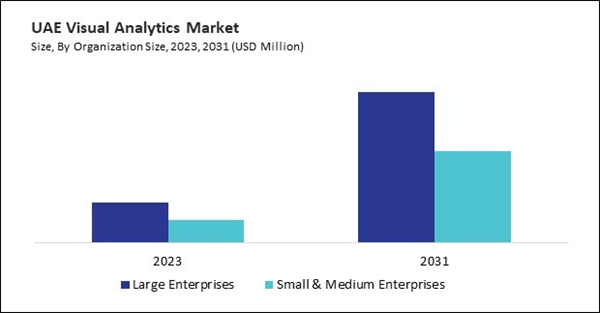The Brazil market dominated the LAMEA Visual Analytics Market by country in 2023, and is expected to continue to be a dominant market till 2031; thereby, achieving a market value of $508.2 million by 2031. The Argentina market is experiencing a CAGR of 21.6% during 2024-2031. Additionally, the UAE market is expected to exhibit a CAGR of 19% during 2024-2031.
Several key trends are shaping the future of the market. AI and ML technologies are integrated into visual analytics platforms to enhance their capabilities. These technologies enable automated pattern recognition, anomaly detection, and predictive modeling, improving the accuracy and effectiveness of visual analytics. The rise of self-service analytics platforms empowers business users to explore data without relying on IT departments or data scientists. These platforms are designed with intuitive interfaces, making it easier for non-technical users to create visualizations, perform analyses, and generate reports independently.
As businesses embrace remote work and digital collaboration, visual analytics platforms are evolving to facilitate teamwork. These platforms enable multiple users to interact with the same visualizations, share insights, and collaborate on data-driven decisions. NLP technologies are integrated into visual analytics platforms, allowing users to interact with data using natural language queries. This makes it easier for non-technical users to ask questions and get answers without understanding complex query languages.
Brazil’s e-commerce sector is expected to surpass US$200 billion by 2026, with an annual growth rate of 14.3%. This growth will lead to an increase in transactional and consumer behavior data, which must be analyzed effectively. Visual analytics will be crucial for businesses in Brazil’s e-commerce industry to track customer preferences, optimize marketing campaigns, and improve customer experiences. These tools will help businesses gain valuable insights from large datasets, enabling them to stay competitive in an increasingly crowded online marketplace.
Brazil’s booming e-commerce sector will drive the need for more efficient operations. Visual analytics will allow e-commerce companies to monitor and optimize various aspects of their operations, including inventory management, supply chain logistics, and pricing strategies. With large volumes of data from online sales, customer interactions, and product performance, visual analytics tools will help businesses gain real-time insights to streamline their operations, reduce inefficiencies, and enhance profitability. Thus, the rapid growth of the logistics sector in the UAE and the e-commerce sector in Brazil will significantly impact the market in both countries.
List of Key Companies Profiled
- IBM Corporation
- Oracle Corporation
- SAP SE
- Microsoft Corporation
- SAS Institute Inc.
- Cisco Systems, Inc.
- TIBCO Software, Inc. (Vista Equity Partners Management, LLC)
- Salesforce, Inc.
- Google LLC (Alphabet Inc.)
- Hewlett Packard Enterprise Company
Market Report Segmentation
By Deployment Mode- Cloud
- On-premise
- Solution
- Services
- Professional Services
- Managed Services
- Sales & Marketing
- Finance & IT
- Supply Chain Management
- Human Resource
- Other Business Function
- Large Enterprises
- Small & Medium Enterprises
- BFSI
- Government
- Energy & Utilities
- Healthcare
- Manufacturing
- Retail
- Telecom & IT
- Other Vertical
- Brazil
- Argentina
- UAE
- Saudi Arabia
- South Africa
- Nigeria
- Rest of LAMEA
Table of Contents
Companies Mentioned
- IBM Corporation
- Oracle Corporation
- SAP SE
- Microsoft Corporation
- SAS Institute Inc.
- Cisco Systems, Inc.
- TIBCO Software, Inc. (Vista Equity Partners Management, LLC)
- Salesforce, Inc.
- Google LLC (Alphabet Inc.)
- Hewlett Packard Enterprise Company
Methodology

LOADING...









